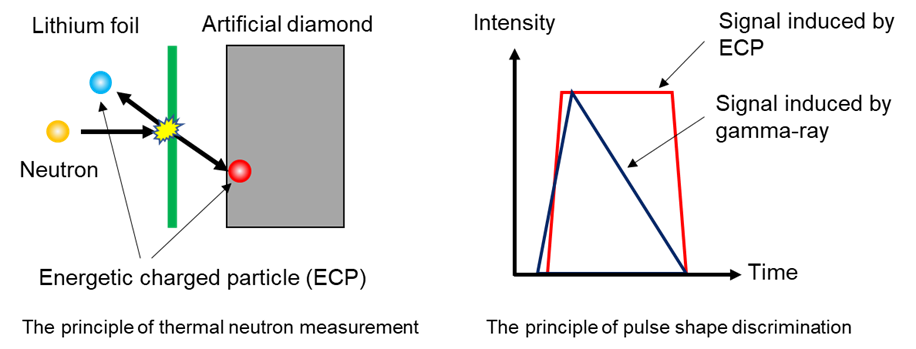Neutron measurement using an artificial diamond
We established the pulse shape discrimination method for evaluating thermal neutron flux using artificial diamond detector. By this method, the detection efficiency of thermal neutron increased with 1.5 times compared to the previous work. This work can improve the neutron control and measurement system in the fusion reactor.

We established a pulse shape discrimination method for evaluating thermal neutron flux using an artificial diamond detector. By this method, the detection efficiency of thermal neutrons increased 1.5 times, compared to the previous work. This work can improve the neutron control and measurement system in a fusion reactor.
In a fusion reactor, a blanket, which surrounds the plasma, works to shield fast neutrons to produce energy and fuel. The evaluation of thermal neutron flux in the blanket is important for monitoring the steady generation of fuel. There have been many thermal neutron detectors developed so far. However, due to the harsh temperature and radiation environment in the blanket, conventional detectors cannot be available for long-time operation. In this work, the NIFS research group, in collaboration with researchers at the ENEA (Italy), Nagoya University and Tokushima University, studied the thermal neutron measurement method, using an artificial diamond detector which is highly tolerant of radiation and high temperature.
Our method in this work is as follows. A thin lithium foil placed in front of the artificial diamond can react with thermal neutrons to generate energetic charged particles. These particles deposit energy into the diamond, inducing the signal. Besides, because the artificial diamond detector is also sensitive to gamma-rays, a discrimination method to extract the signals induced only by the energetic charged particles needs to be established. We developed a program of the pulse shape discrimination method, based on the pulse shape, in this work.
The artificial diamond detector was installed into the LHD torus hall to be exposed to the neutrons and gamma-rays generated during the deuterium experiment in the LHD. The nuclear reaction between thermal neutrons and lithium resulted in generation of two kinds of energetic charged particles. According to the pulse shape discrimination method, we found two corresponding peaks in the deposited energy histogram. This result indicates that the measurement of thermal neutrons in a gamma-ray environment is possible with this method. Also, due to the capability of the extraction of a lower energy peak, which is usually shaded by the environmental gamma-rays, the detection efficiency of thermal neutrons increased 1.5 times by this method.
As mentioned above, the neutron detectors in the blanket must work under high temperature and a harsh radiation field. The diamond is intrinsically tolerant of high temperature and radiation. From the method in the present research, the capability of thermal neutron measurement in a gamma-ray radiation field was achieved. Accordingly, the present research can contribute to the monitoring of neutron and fuel generation in a fusion reactor.
This research result was published on October 19, 2020 in Fusion Engineering and Design, an international journal on fusion energy and technology.
